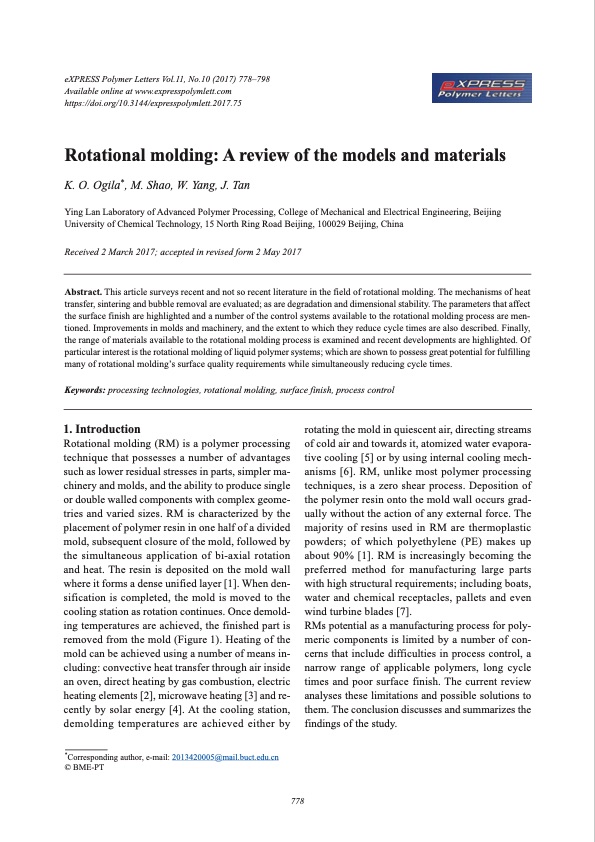
PDF Publication Title:
Text from PDF Page: 002
eXPRESS Polymer Letters Vol.11, No.10 (2017) 778–798 Available online at www.expresspolymlett.com https://doi.org/10.3144/expresspolymlett.2017.75 Rotational molding: A review of the models and materials K. O. Ogila*, M. Shao, W. Yang, J. Tan Ying Lan Laboratory of Advanced Polymer Processing, College of Mechanical and Electrical Engineering, Beijing University of Chemical Technology, 15 North Ring Road Beijing, 100029 Beijing, China Received 2 March 2017; accepted in revised form 2 May 2017 Abstract. This article surveys recent and not so recent literature in the field of rotational molding. The mechanisms of heat transfer, sintering and bubble removal are evaluated; as are degradation and dimensional stability. The parameters that affect the surface finish are highlighted and a number of the control systems available to the rotational molding process are men- tioned. Improvements in molds and machinery, and the extent to which they reduce cycle times are also described. Finally, the range of materials available to the rotational molding process is examined and recent developments are highlighted. Of particular interest is the rotational molding of liquid polymer systems; which are shown to possess great potential for fulfilling many of rotational molding’s surface quality requirements while simultaneously reducing cycle times. Keywords: processing technologies, rotational molding, surface finish, process control 1. Introduction Rotational molding (RM) is a polymer processing technique that possesses a number of advantages such as lower residual stresses in parts, simpler ma- chinery and molds, and the ability to produce single or double walled components with complex geome- tries and varied sizes. RM is characterized by the placement of polymer resin in one half of a divided mold, subsequent closure of the mold, followed by the simultaneous application of bi-axial rotation and heat. The resin is deposited on the mold wall where it forms a dense unified layer [1]. When den- sification is completed, the mold is moved to the cooling station as rotation continues. Once demold- ing temperatures are achieved, the finished part is removed from the mold (Figure 1). Heating of the mold can be achieved using a number of means in- cluding: convective heat transfer through air inside an oven, direct heating by gas combustion, electric heating elements [2], microwave heating [3] and re- cently by solar energy [4]. At the cooling station, demolding temperatures are achieved either by rotating the mold in quiescent air, directing streams of cold air and towards it, atomized water evapora- tive cooling [5] or by using internal cooling mech- anisms [6]. RM, unlike most polymer processing techniques, is a zero shear process. Deposition of the polymer resin onto the mold wall occurs grad- ually without the action of any external force. The majority of resins used in RM are thermoplastic powders; of which polyethylene (PE) makes up about 90% [1]. RM is increasingly becoming the preferred method for manufacturing large parts with high structural requirements; including boats, water and chemical receptacles, pallets and even wind turbine blades [7]. RMs potential as a manufacturing process for poly- meric components is limited by a number of con- cerns that include difficulties in process control, a narrow range of applicable polymers, long cycle times and poor surface finish. The current review analyses these limitations and possible solutions to them. The conclusion discusses and summarizes the findings of the study. *Corresponding author, e-mail: 2013420005@mail.buct.edu.cn © BME-PT 778PDF Image | Rotational molding: A review

PDF Search Title:
Rotational molding: A reviewOriginal File Name Searched:
Rotational_molding_A_review_of_the_models_and_mate.pdfDIY PDF Search: Google It | Yahoo | Bing
Development of a solar powered Electric Ship The Electricship website originally started off as a project to develop a comprehensive renewable, affordable, modular electric ship... More Info
Modular Boat Hull Composite The case for a unsinkable, modular composite hybrid boat hull... More Info
MS Burgenstock Hybrid Electric Catamaran Lake Lucerne Unique shuttle servicing Lucerne to the Burgenstock Resort... More Info
Ground Power Unit GPU Powered by Lithium Ion Batteries The goal of the Ground Power Unit is to provide a readily accessible, modular, ready-to-power solution for remote power... More Info
| CONTACT TEL: 608-238-6001 Email: greg@electricship.com | RSS | AMP |